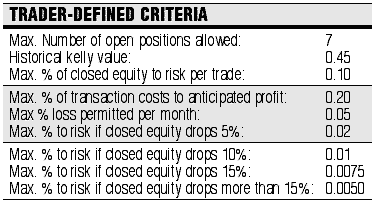MONEY MANAGEMENT
Designing A Money Management Strategy
Using Volatility-Based Stops And The Kelly Criterion
by Ray Overholser, O.D.
Sorting out the criteria for a coherent money management plan is a complex, detailed job. Using a spreadsheet to keep track of the logic helps ensure nothing has been omitted.
With a little planning, you can develop a logically sound money management system. Historically, too much emphasis has been placed on the development of profitable entry and exit rules, whereas the determination of the proper number of contracts or shares to trade has been treated as a distant afterthought.

FIGURE 1: PERSONAL ASSUMPTIONS. In this spreadsheet, a number of values limit the size of positions. The values shown can be altered to reflect your own.
An individualized money management algorithm (using a spreadsheet program such as Microsoft Excel) will control the equity growth of any positive-expectancy system as a direct function of using correct position sizing. Risking too large a portion of trading capital per position will eventually cause even the most profitable trading system to fail.
The second advantage to developing your own position-sizing strategy is to preserve trading capital during periods of extended drawdown or losing trades. This saves you the money to trade when things finally turn around. Unfortunately, many traders inadvertently lose their hard-earned trading capital as a result of improper position sizing. This becomes painfully obvious when they have risked too much capital over an extended series of losing trades.
I developed an effective money management algorithm using Excel 5.0. It is based on the theory of using volatility-derived stop-losses as a logical method to allocate capital. The logic behind using a volatility-based stop compared with a fixed-dollar stop is that the volatility-based stop can dynamically adjust to changes in a stock's recent price noise. This contrasts to trading with a fixed-dollar stop, which ignores volatility by forcing the placement of an externally derived, subjective stop without considering the underlying trade's true character.
As an example, assume stock XYZ has traded within a range of $10 to $12 per share over the last 14 days, with an average price during that time of $11 per share and a standard deviation of $2. A stop-loss could be placed at the time of entry, representing twice the standard deviation of $2 per share. Setting the stop at this $4 per share risk acts as a useful proxy of the stock's recent two-week normal price fluctuations. A stop-loss placed at this level is now less likely to suffer whipsaw losses solely because of a stock's normal price volatility.
My algorithm allows a portfolio to grow at an above-average rate of return while consistently controlling risk. You should examine the assumptions inherent in my model and make changes in the values to reflect your own overall risk tolerance and trading philosophy. My algorithm is based on the following personal assumptions (Figure 1):
1 The maximum number of open positions is limited to 7.
2 The maximum risk per position is limited to 2% of closed equity plus 80% of the Kelly value multiplied by open profits, the sum divided by maximum number of allowed positions less number of current positions open.
Ray Overholser, O.D., is a private trader in Gainesville, FL. He is completing a graduate business degree at the University of Florida, with the goal of opening a hedge fund based on his research in technical analysis and money management. He plans to launch an online newsletter at www.WealthByStrategy.com. He can be reached by E-mail at stocktrader@writeme.com.
Excerpted from an article originally published in the May 2000 issue of Technical Analysis of STOCKS & COMMODITIES magazine. All rights reserved. © Copyright 2000, Technical Analysis, Inc.
Return to May 2000 Contents